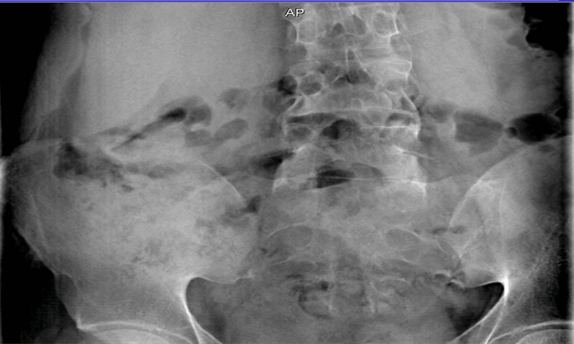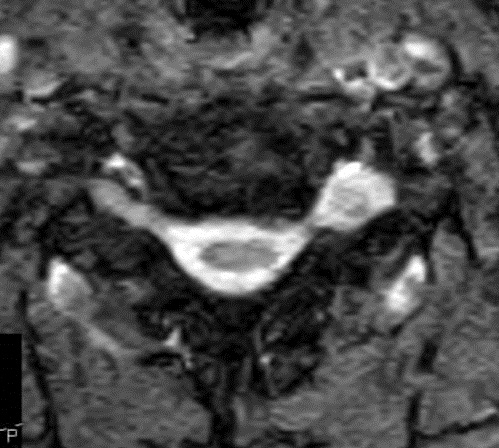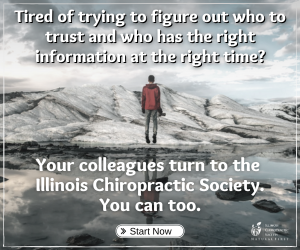
Ankylosing Spondylitis

I was presented with a case last month of a 28-year old male patient with chronic lower back pain. The images that were sent were of an AP and lateral lumbar spine. The patient had not been seen by any other health care practitioners prior to his visit to the DC who sent me the films for evaluation. I have included them here, figure 1 is a cropped version of the AP lumbar projection and figure 2 a full lateral lumbar projection.

I have submitted a cropped AP film in order to hopefully accentuate the findings of the sacroiliac joints. In figure 1, the sacroiliac joints are virtually non-existent. There is the suggestion of where they should be located, but the normal sharp contour of the margins of the joint is missing. This involves the entire joint, bilaterally. In figure 2, there are sharp calcifications at the anterior margins of the disc that extend from one corner of the vertebral body to the next at the L3-L4, L4-L5 and less obviously at the L5-S1 levels.

The lack of visible SI joints is indicative of an inflammatory etiology. In the setting of chronic lower back pain in a young individual, a seronegative spondyloarthropathy would be the prime consideration, with ankylosing spondylitis (AS) being the most likely etiologyunless, of course, there is a known history of psoriatic dermatitis or inflammatory bowel disease which would point to other seronegatives. This patient lacked such a history and AS was presumed to be the most likely cause. This case is a fairly obvious representation of AS radiographically. But what if we have a case in which it is too early to see radiographic changes? It often takes years for radiographic changes to become manifest. Let me explain why I bring up this subject.
I listen to a lot of sports talk radio. Within the last year or so, I have repeatedly heard a radio advertisement that talked about ankylosing spondylitis. It seems like a strange topic for an advertiser. The radio spot features a somewhat gravelly voiced narrator, who was apparently chosen to reflect a somewhat sinister background for the ad. The narrator is supposed to represent the disease ankylosing spondylitis and goes on to describe himself in terms of the symptoms he might create and to imply that someone’s back pain may be due to this malady and not simply be due to one of the other myriad of causes of back pain. Of course he doesn’t describe at all the likelihood of a person’s back pain is due to the other back pain sources, as opposed to AS. I began to wonder who would be behind such an ad campaign, because ostensibly the campaign is to further awareness of AS. I immediately had my suspicions; however the identity of the sponsor of the ad is not made immediately apparent. It was suggested that people log onto a website for AS that would administer a quiz to determine if you might have the disease.
I went to the website, and lo and behold, the sponsor is a major drug manufacturer. Furthermore, the quiz was so general that it ruled out almost nothing regarding the cause of back pain. So, in brief, we have a drug company promoting a disease for which they happen to have a drug treatment. The drug is a TNF inhibiting anti-inflammatory drug used for AS.
So what is wrong with this scenario? Well to start, an alarmist state is created. Some people, maybe a lot of people, will think that their back pain is due to AS or at least are frightened enough to think that they might have it. We know that the vast majority of back pain is biomechanical in nature. AS represents 4%-5% of chronic low back pain patients and the occurrence of AS in the population, in general, is 0.1-1.4% of individuals (1). Is it really appropriate to suggest that a person may be afflicted with this disease based on a general low back pain quiz, based on these figures? I think everyone would agree that the answer to this question is a resounding “no.”
How about the fact that this advertisement does not directly identify the drug company as the sponsor? It did mention at the end of the commercial that it was sponsored by a company that turned out to be the drug company’s research and development arm. I have a big problem with that as well. The ad almost comes off as a public service announcement. The population at large regards these ads as having a certain intrinsic validity. When we know that an advertisement is sponsored by a private company, then we realize that the facts may be slanted in a certain direction to favor that company and may not be purely objective. It is only by actually going to the website and taking the quiz that we realize that the ad is privately sponsored. By that time many people are already hooked into thinking that they may have the disease. The person is then encouraged to consult his or her doctor.
Okay, so what is so wrong about making someone aware of a disease and urging them to see a doctor? Nothing, if the person has the disease and is diagnosed and treated appropriately. The problem starts, however, when the person already suspects that he or she has a certain disease and consults a doctor that is not particularly knowledgeable about the disease. Add to this the fact that AS can be particularly difficult to diagnose. It often takes years for x-ray findings to become manifest in AS cases and the only blood work available is the detection of HLA-B27 antigen, which is nonspecific, as many in the general population have the antigen and do not have AS. An elevated ESR level and mild anemia are possible findings (2). The bottom line is that individuals with back pain may or may not have AS but may be treated as if they do. So now another scenario may be created where patients may be given drug therapy for a disease they do not have.
Perhaps I am a bit over-reactionary, but in my opinion, in the current age of promoting taking a drug for any and all ailments, I am not sure that an advertisement such as this one can be considered ethical. Patients are better served by evidence-based information whose sources are plainly provided.
References:
- www.clevelandclinicmeded.com/medicalpubs/diseasemanagement/rheumatology/ankylosing-spondylitis.
- Yochum T.R., Rowe L.J.: Essentials of Skeletal Radiology, ed 3. Philadelphia, Lippincott Williams & Wilkins, 2005.

















